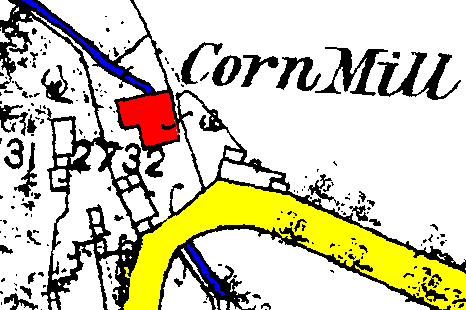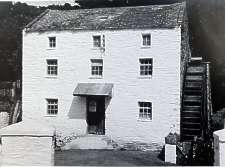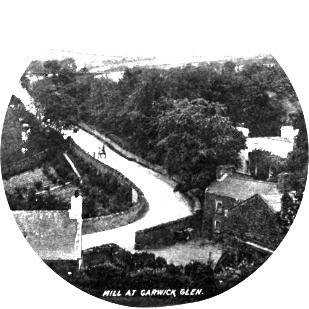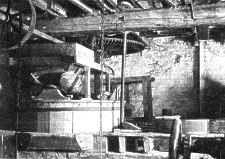The mention of stone pillars in above, very condensed, agreement would suggest
that the water was for part of the race was carried in a wooden tranche later
replaced by a newly cut channel - also that the mill had a dam (or reservoir)
by 1878 - no such dam is shown on the 1868 plan.
SHOCKING DEATH IN KIRK LONAN.
A MAN'S LEG CRUSHED OFF BY A MILL WHEEL. — MARVELLOUS
COURAGE OF THE SUFFERER.— HE GIVES DIRECTIONS HOW TO EXTRICATE HIM.
Another distressing accident, resulting in death, occurred on Friday afternoon,
in the Ballagawne Mill, near Baldrine, in the parish of Lonan, Robert Fayle,
miller, being the person who met with the mishap. On Saturday afternoon, his
Worship the High-Bailiff, coroner of inquests for the district, held an enquiry
as to the cause of the death of Fayle, who leaves ten young children to mourn
his loss, and the evidence given at the inquisition is fully reported below.
This is the sixth inquest his Worship has held within the space of three weeks.
John James Fayle deposed : The deceased Robert Fayle was my father. He lived
at the miller's house at the Ballagawne Mill. He was 54[sic 45] years
of age, and has been miller at the mill for the past 13 years. I assisted
my father in the mill. It is a water corn mill, and is propelled by an overshot
wheel. The cogwheel and shaft of the wheel are on the second floor, and over
this cog-wheel there is a loft. The cog-wheel has arms above the rim of the
wheel, and these arms are immediately under the beams and flooring of the
loft. The corn is placed in the loft, where the hoppers are, and the mill
is fed with corn from above. The axle of this principal wheel is fastened
into a socket in this loft. Immediately over the wheel there was a slight
boarding close to the hopper. It was part of my father's duty to be on this
loft to empty the sacks of corn into the hopper, and then he would come down
stairs and attend to receive the oatmeal. Yesterday he went to work as usual.
I was down stairs in the mill, it being my duty to regulate the driving power,
and my father was at this time — about three in the afternoon —
in the loft supplying the mill at the hopper, and two floors above where I
was. I noticed the speed of the mill was changed, and it began to go too quick
for me to attend and regulate the speed, so I at once went up stairs on the
loft to see what my father was about, and when I got on the loft I saw him
lying fastened with one leg between the arms of the driving wheel and the
floor of the loft. I instantly ran down stairs and stopped the mill, and then
ran up again to where my father was caught in the wheel. He asked me if I
had stopped the mill, and I replied that I had. I then ran to our house, which
is next to the mill, and told my mother. I returned and went up to my father
again, and found that his right leg was completely held between the arms of
the wheel and floors of the loft. I remained with my father in that position
for an hour. He told us how it had happened — that he has just been feeding
the mill at the hopper, and had placed his foot on the boarding just above
the wheel when the boarding gave way, and his leg went through the hole and
came in contact with the wheel, which nearly separated the leg from his body;
and if I had not stopped the mill when I did he would have been dragged downwards
into the machinery of the mill. Instantly assistance came his clothes were
cut off. My father was left where he was until Dr. Elliott, who had been sent
for, arrived. I assisted in getting my father out, and one hour elapsed before
he was taken from the mill.
Edward Gelling said : I live at the Cloven Stones, near to Ballagawne Mill,
and when sent for about three o'clock yesterday evening, I went to the mill
at once. Deceased was very steady, and knew his duty very well. When I went
up on to the loft I saw Fayle in the position described by his son. He was
quite sensible, but appeared in great pain, and to have lost a great quantity
of blood. I assisted to cut off his clothes, and when that was done I saw
the bare bone at the thigh, which was broken, and the leg where it was separated
was merely held by the flesh, and the other portion of the clothes which we
could not get at to cut. When Dr. Elliott came, that which was holding the
lower part of his leg to his body was severed, and the deceased was removed
to his own house. He remained perfectly sensible, and when I left his house
about five o'clock everything that could be was done for him.
Dr. P. Elliott, medical practitioner, Douglas, examined : I was in Laxey
yesterday, and a message came to me that deceased had been caught in the machinery
of the mill. I went off at once, and when I got to the mill I went up to the
loft, where I saw the deceased lying on his back fastened in the machinery.
Those about him were doing everything in their power to relieve him, under
the instructions they were receiving from the deceased himself. He was ordering
those present to back the wheel, and cut his leg off, which I had to do there
and then to get him out of his perilous position. When I cut the flesh, which
alone held the one portion of the leg to the other, he expressed himself greatly
relieved, and asked to be taken to his own house as quickly as possible, which
was done. He then became unconscious, and never rallied. Death was caused
by the shock, the loss of blood, and the injuries he received.
John Wallace, a neighbour of deceased's said that at about half-past six
the previous evening, he went into deceased's room, and he was then unconscious
and breathing his last, and died immediately after witness went into the room.
The jury returned a verdict in accordance with the medical testimony, adding
the follow rider:— "That it would be very desirable if there could
be some legal provision made in order that there should be a periodical inspection
of all premises where there is machinery in motion, in order that a report
might be made as to the state of the flooring, and in other respects as to
the general condition of the premises, and thereby prevent, if possible, accidents
occurring from inefficient machinery or from the decay of flooring, or the
same being out of repair."
The son John James would be about 15 years old at the time.




